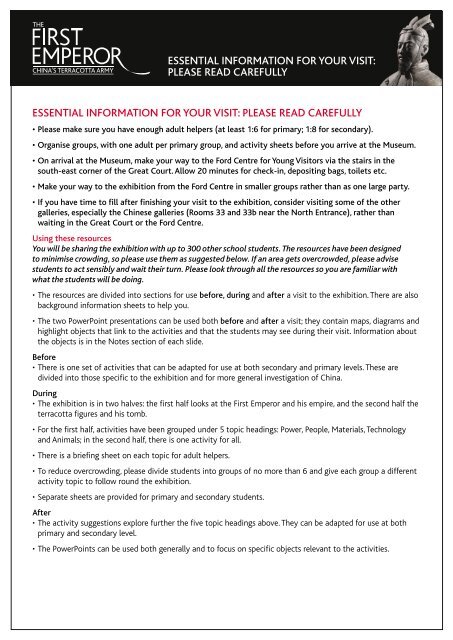RESOURCES FOR TEACHERS - British Museum
RESOURCES FOR TEACHERS - British Museum
RESOURCES FOR TEACHERS - British Museum
Create successful ePaper yourself
Turn your PDF publications into a flip-book with our unique Google optimized e-Paper software.
ESSENTIAL IN<strong>FOR</strong>MATION <strong>FOR</strong> YOUR VISIT: PLEASE READ CAREFULLY<br />
• Please make sure you have enough adult helpers (at least 1:6 for primary; 1:8 for secondary).<br />
• Organise groups, with one adult per primary group, and activity sheets before you arrive at the <strong>Museum</strong>.<br />
• On arrival at the <strong>Museum</strong>, make your way to the Ford Centre for Young Visitors via the stairs in the<br />
south-east corner of the Great Court. Allow 20 minutes for check-in, depositing bags, toilets etc.<br />
• Make your way to the exhibition from the Ford Centre in smaller groups rather than as one large party.<br />
• If you have time to fill after finishing your visit to the exhibition, consider visiting some of the other<br />
galleries, especially the Chinese galleries (Rooms 33 and 33b near the North Entrance), rather than<br />
waiting in the Great Court or the Ford Centre.<br />
Using these resources<br />
You will be sharing the exhibition with up to 300 other school students. The resources have been designed<br />
to minimise crowding, so please use them as suggested below. If an area gets overcrowded, please advise<br />
students to act sensibly and wait their turn. Please look through all the resources so you are familiar with<br />
what the students will be doing.<br />
• The resources are divided into sections for use before, during and after a visit to the exhibition. There are also<br />
background information sheets to help you.<br />
• The two PowerPoint presentations can be used both before and after a visit; they contain maps, diagrams and<br />
highlight objects that link to the activities and that the students may see during their visit. Information about<br />
the objects is in the Notes section of each slide.<br />
Before<br />
• There is one set of activities that can be adapted for use at both secondary and primary levels. These are<br />
divided into those specific to the exhibition and for more general investigation of China.<br />
During<br />
• The exhibition is in two halves: the first half looks at the First Emperor and his empire, and the second half the<br />
terracotta figures and his tomb.<br />
• For the first half, activities have been grouped under 5 topic headings: Power, People, Materials, Technology<br />
and Animals; in the second half, there is one activity for all.<br />
• There is a briefing sheet on each topic for adult helpers.<br />
• To reduce overcrowding, please divide students into groups of no more than 6 and give each group a different<br />
activity topic to follow round the exhibition.<br />
• Separate sheets are provided for primary and secondary students.<br />
ESSENTIAL IN<strong>FOR</strong>MATION <strong>FOR</strong> YOUR VISIT:<br />
PLEASE READ CAREFULLY<br />
After<br />
• The activity suggestions explore further the five topic headings above. They can be adapted for use at both<br />
primary and secondary level.<br />
• The PowerPoints can be used both generally and to focus on specific objects relevant to the activities.
















